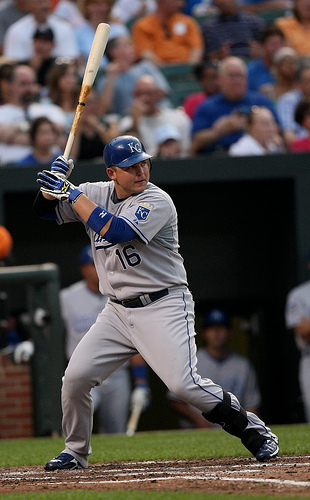DJ Peterson: The best hitter you know nothing about

National attention on top prospects for the upcoming MLB Draft has mostly centered on college pitchers Jonathan Gray (Oklahoma) and Mark Appel (Stanford) with Georgia High School stud Clint Frazier thrown in here and there for color. The college hitting class is thought of as relatively weak, largely because it is, with San Diego’s Kris Bryant’s power and Tar Heel Colin Moran’s selectivity putting each of them in Top 10 status.
Talented though they are, neither Bryant nor Moran may turn into as good a big league hitter as New Mexico third baseman D.J. Peterson.

Could DJ Peterson be the next Billy Butler?
Currently hitting .411/.525/.823 thru 209 ABs, Peterson’s stats are pretty, pretty, prett-ay good. While the Lobos play in a pronounced hitter’s park (generally increasing offensive output by up to 25%) Peterson does not appear to be simply a product of his environment. Peterson has only struck out 12.1% of the time — an elite mark for a college power hitter. Peter has an excellent eye at the plate, drawing walks in 17.4% of plate appearances this spring. The basic components of an at-bat, differentiating balls and strikes, getting a good pitch to hit, hitting it hard somewhere aren’t altered by park. These aspects of hitting are predictive of future success. D.J. Peterson is great in all of them.
Peterson’s swing is a study in efficient power. An economy of motion, Peterson maintains strong balance, wicked hip rotation, and has outstanding natural strength all while maintaining excellent plate coverage. You can put the ball anywhere in the zone and Peterson can hit it hard. Put it outside the zone, he won’t chase. One scout contact said Peterson’s swing was “vastly better” than Kris Bryant’s. Peterson projects to hit for high average, get on-base and hit for power. A .300 average with 30+ home runs is well within reach for Peterson.
So what are the downsides? If this guy’s so great how come he’s not in everybody’s top 5? Why did you break the lawnmower yesterday? Well, imaginary person I made up who likes to argue, the answers to one and two are connected and the lawnmower thing totally wasn’t my fault. The neighbors threw one of those rope chew toys for dogs over the fence and I didn’t see it until after I went over it.
As for Peterson, if he were in a bigger more athletic body he’d be in a dead-heat with Jonathan Gray for the first overall selection. Listed at 6-foot-1 and 190 pounds, Peterson looks an inch or two shorter and 10-15 pounds heavier. He’s a below-average runner, though not long-lost-Molina-level slow. He probably can’t handle third base at the major league level. D.J. Peterson is most likely a first baseman long-term and he won’t make a great jeans model. That’s it. That’s the downside.
College first baseman have, historically, been docked in the MLB Draft. The first college first baseman didn’t get selected in 2012 until the fourth round when Baltimore nabbed South Carolina’s Christian Walker 132nd overall (who is dominating the minors and could have a solid MLB career but that’s another article). No college first baseman has gone in the top 10 since Yonder Alonso went seventh overall in 2008 to the Reds. None has ever gone first overall.
Though last time I checked, first-base is still a position that get’s to play nearly everyday. While the bar for offensive excellence is high, Peterson could certainly clear it. Given his physique, athleticism and skill set it’s hard not to throw a Billy Butler comp on DJ Peterson.
While he’s not the sexiest name, D.J. Peterson may end up being the best hitter in the 2013 Draft. The New Mexico Lobo may not contribute much out of the batter’s box but he’ll destroy pitches like so many rope-chew-toy’d lawnmowers.





